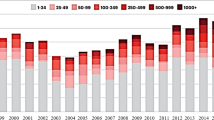Abstract
There is controversy regarding the directional dependence of head responses subjected to blast loading. The goal of this work is to characterize the role of head orientation in the mechanics of blast wave-head interactions as well as the load transmitting to the brain. A three-dimensional human head model with anatomical details was reconstructed from computed tomography images. Three different head orientations with respect to the oncoming blast wave, i.e., front-on with head facing blast, back-on with head facing away from blast, and side-on with right side exposed to blast, were considered. The reflected pressure at the blast wave-head interface positively correlated with the skull curvature. It is evidenced by the maximum reflected pressure occurring at the eye socket with the largest curvature on the skull. The reflected pressure pattern along with the local skull areas could further influence the intracranial pressure distributions within the brain. We did find out that the maximum coup pressure of 1.031 MPa in the side-on case as well as the maximum contrecoup pressure of −0.124 MPa in the back-on case. Moreover, the maximum principal strain (MPS) was also monitored due to its indication to diffuse brain injury. It was observed that the peak MPS located in the frontal cortex region regardless of the head orientation. However, the local peak MPS within each individual function region of the brain depended on the head orientation. The detailed interactions between blast wave and head orientations provided insights for evaluating the brain dynamics, as well as biomechanical factors leading to traumatic brain injury.




Similar content being viewed by others
References
Davenport ND, Lim KO, Armstrong MT, Sponheim SR. Diffuse and spatially variable white matter disruptions are associated with blast-related mild traumatic brain injury. Neuroimage. 2012;59:2017–24.
Kleinschmit NN. A shock tube technique for blast wave simulation and studies for flow structure interactions in shock tube blast experiments, Degree of Master of Science, Department of Engineering Mechanics, University of Nebraska-Lincoln, Lincoln. 2011.
Wang C, Pahk JB, Balaban CD, Miller MC, Wood AR, Vipperman JS. Computational study of human head response to primary blast waves of five levels from three directions. PLoS ONE. 2014;9:e113264.
Hodgson VR, Thomas LM, Khalil TB. The role of impact location in reversible cerebral concussion, SAE Technical Paper. 1983.
Gennarelli TA, Thibault LE, Tomei G, Wiser R, Graham D, Adams J. Directional dependence of axonal brain injury due to centroidal and non-centroidal acceleration, SAE Technical Paper. 1987.
Zhang L, Yang KH, King AI. Comparison of brain responses between frontal and lateral impacts by finite element modeling. J Neurotrauma. 2001;18:21–30.
Taylor PA, Ford CC. Simulation of Blast-induced early-time intracranial wave physics leading to traumatic brain injury. J Biomech Eng Trans Asme. 2009;131:061007.
Zhang L, Makwana R, Sharma S. Brain response to primary blast wave using validated finite element models of human head and advanced combat helmet. Front Neurol. 2013;4:88.
Leonardi ADC, Keane NJ, Bir CA, Ryan AG, Xu L, VandeVord PJ. Head orientation affects the intracranial pressure response resulting from shock wave loading in the rat. J Biomech. 2012;45:2595–602.
Chavko M, Watanabe T, Adeeb S, Lankasky J, Ahlers ST, McCarron RM. Relationship between orientation to a blast and pressure wave propagation inside the rat brain. J Neurosci Methods. 2011;195:61–6.
Hua Y, Akula PK, Gu L, Berg J, Nelson CA. Experimental and numerical investigation of the mechanism of blast wave transmission through a surrogate head. J Comput Nonlinear Dyn. 2014;9:031010.
Aravind S, Aaron A, Shailesh G, Aaron H, Erwan P, Namas C. Blast-induced biomechanical loading of the rat: an experimental and anatomically accurate computational blast injury model. J Neurotrauma. 2012;29:2352–64.
Chafi MS, Dirisala V, Karami G, Ziejewski M. A finite element method parametric study of the dynamic response of the human brain with different cerebrospinal fluid constitutive properties. Proc Inst Mech Eng Part H J Eng Med. 2009;223:1003–19.
Hua Y, Akula PK, Gu L. Experimental and numerical investigation of carbon fiber sandwich panels subjected to blast loading. Compos B Eng. 2014;56:456–63.
Akula P, Hua Y, Gu L. Blast-induced mild traumatic brain injury through ear canal: a finite element study. Biomed Eng Lett. 2015;5:281–8.
Ganpule S, Gu L, Alai A, Chandra N. Role of helmet in the mechanics of shock wave propagation under blast loading conditions. Comput Methods Biomech Biomed Eng. 2012;15:1233–44.
Mao H, Unnikrishnan G, Rakesh V, Reifman J. Untangling the effect of head acceleration on brain responses to blast waves. J Biomech Eng. 2015;137:124502.
Ruan J, Khalil T, King A. Dynamic response of the human head to impact by three-dimensional finite element analysis. J Biomech Eng. 1994;116:44–50.
Morrison B 3rd, Cater HL, Wang C, Thomas FC, Hung CT, Ateshian GA, Sundstrom LE. A tissue level tolerance criterion for living brain developed with an in vitro model of traumatic mechanical loading. Stapp Car Crash J. 2003;47:93.
Mao H, Guan F, Han X, Yang KH. Strain-based regional traumatic brain injury intensity in controlled cortical impact: a systematic numerical analysis. J Neurotrauma. 2011;28:2263–76.
Bayly PV, Black EE, Pedersen RC, Leister EP, Genin GM. In vivo imaging of rapid deformation and strain in an animal model of traumatic brain injury. J Biomech. 2006;39:1086–95.
Kuijpers A, Claessens M, Sauren A. The influence of different boundary conditions on the response of the head to impact: a two-dimensional finite element study. J Neurotrauma. 1995;12:715–24.
Author information
Authors and Affiliations
Corresponding author
Ethics declarations
Conflict of interest
The authors declare that there is no conflict of interests regarding the publication of this article.
Rights and permissions
About this article
Cite this article
Hua, Y., Wang, Y. & Gu, L. Primary blast waves induced brain dynamics influenced by head orientations. Biomed. Eng. Lett. 7, 253–259 (2017). https://doi.org/10.1007/s13534-017-0027-2
Received:
Revised:
Accepted:
Published:
Issue Date:
DOI: https://doi.org/10.1007/s13534-017-0027-2




